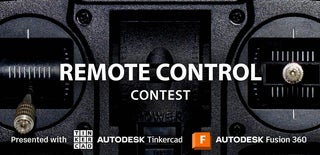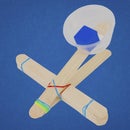Introduction: Make Anything Into an RC Car
I've always been amused by the idea of transforming unconventional objects into an RC vehicle, like a remote control pizza. Even more amusing is when that pizza also has some oversized googly eyes!
This quick Instructable will show you how to transform any smallish household object into a silly RC vehicle for about $20 and 20 minutes.
Supplies
I made a DIY RC Parts Kit so others can easily make just about anything into an RC vehicle, or buy the parts individually:
- 4 channel or 5 channel remote control circuit (Note: AliExpress is great for inexpensive electronics parts if you're not in a hurry)
- gearbox "tt" motors with wheels*
- 3x AA battery holder with switch
- Masking tape or duct tape
- Adhesive squares or hot glue
- A smooth, round object (plastic egg half, ping pong ball half), or project wheels
- Googly eyes - absolutely essential!
You'll also need an object you want to remote control, and maybe some cardboard and scissors. I suggest using something that's smaller than 12x12x12" and weighs less than 2lbs.
*These yellow gearbox motors have high torque which makes it very easy to create a drivable car. Typical DC hobby motors usually don't have enough torque for a toy car without some kind of pulley or gear reduction. They also have flat sides which makes it easy to attach to lots of different things.
Note: You can speed up or slow down your RC creation with different amounts of batteries. A 2x AA battery holder (3v) will move at a more deliberate, plodding pace. 4x AA batteries (6v) will be quite zippy, and a single 9v battery will be so fast it might be difficult to control (and will need to be changed often)! I personally prefer 3x AA batteries (4.5v). More voltage may also be a good idea if your chosen object weighs more than a couple pounds.
Step 1: Create the RC Circuit
Create the RC circuit by connecting the RC receiver wires to the motors. The polarity isn't important because the entire motor can be rotated so the wheels spin in the direction you need for your car.
For the 5 channel receiver/transmitter set, the LR nodes are connected to one motor and the BF nodes are connected to the other. The V+ and V- nodes are connected to the corresponding battery holder wires.
The M+ and M- nodes can be used for a 3rd motorized action by pressing the center button on the remote. In this example the 5th channel is unused.
Cover the battery holder wires with tape to prevent a short circuit.
Step 2: Attach the RC Circuit and Wheels
Before attaching the motors to your object of choice, test the direction the wheels spin. Make sure both wheels are turning in the direction you expect when you press on the controller inputs. If they don't, detach the wheel, flip the motor around so the other powered axle is facing outward, and reattach the wheel.
Attach the motors to the sides of your object with adhesive squares or hot glue. Hot glue is more durable, but adhesive squares allow you to reuse the components more easily.
Important: Attach the battery holder between the motors. The weight of the batteries gives the wheels better traction, and it balances the car better so it can spin faster. If there's not enough space, then attach it as close to the motors as possible.
Important: Raise the antenna. In this 5-channel circuit, the antenna is the white wire. Tape it to the side of the box so the exposed metal part is as high as possible. You can extend the remote control range by soldering or twisting a conductive metal wire to the antenna and raising it even higher.
Lastly, attach a smooth rounded object to the other end of the object to reduce friction. Hot glue or several pieces of tape will work better than adhesive squares.
Step 3: Test It Out!
Give your car some personality with big googly eyes, then try it out!
Try driving straight by pressing both Up buttons at once. If the car spins, then undo one motor, turn it around, and reattach it.
Spin the car by pressing one Up and one Down button at the same time.
Make a slow, wide turn by pressing just one button.
Step 4: Adapting for Oddly-shaped Objects
For objects that are uneven, or don't adhere well to adhesives, or are too valuable to ruin with hot glue, attach a piece of cardboard to the underside with masking tape first, then follow the steps above.
There are endless ways to customize this idea: make a remote control picture frame, a book, a lunchbox, a cat toy, wireless speakers, an empty carton of milk, or even an old shoe! Each object may come with its own unique challenges so be prepared to do a little troubleshooting. When you're tired of one RC object, remove the components and make a new one. Happy making!

Second Prize in the
Remote Control Contest













